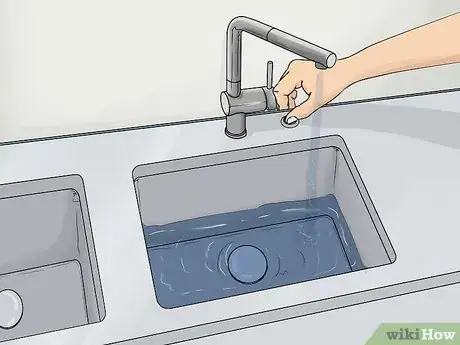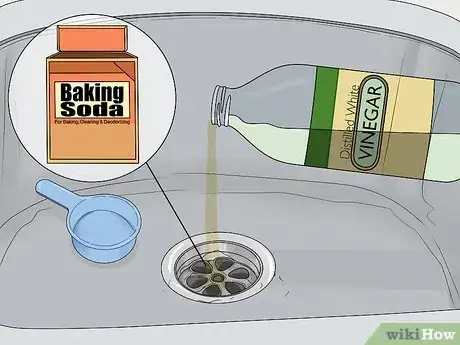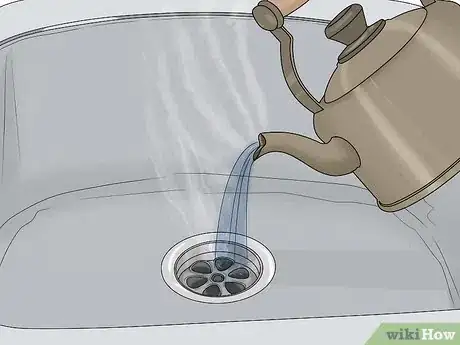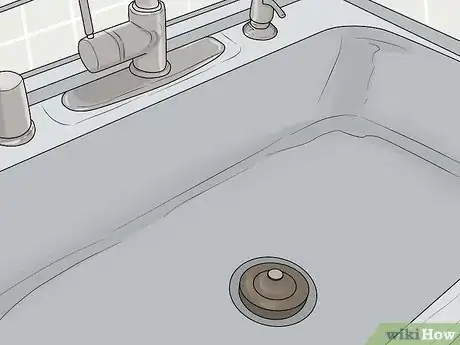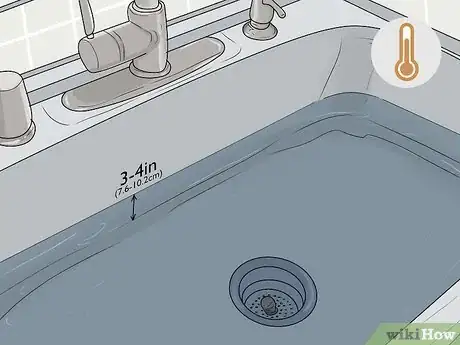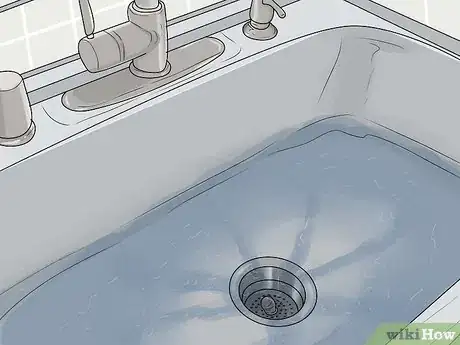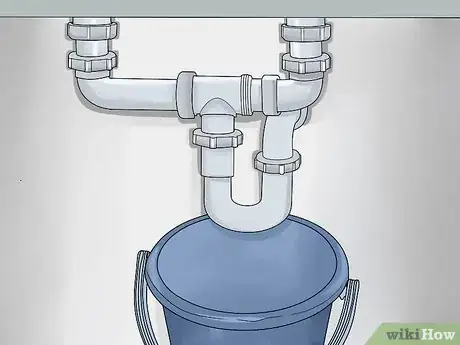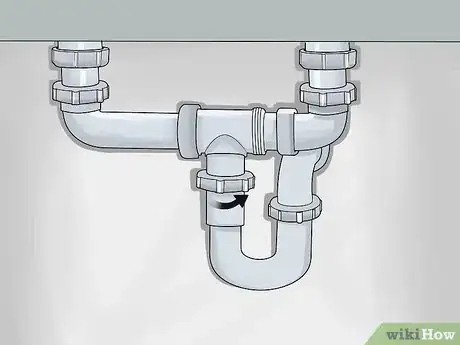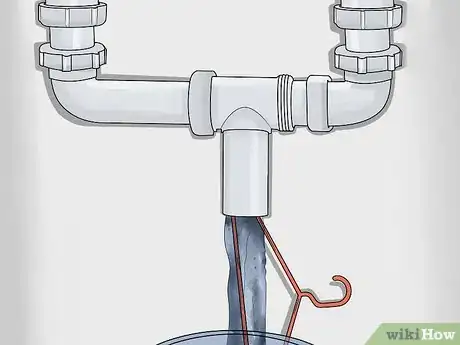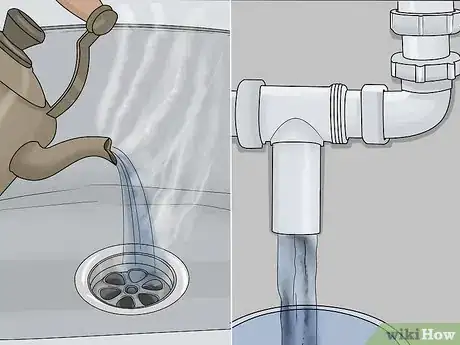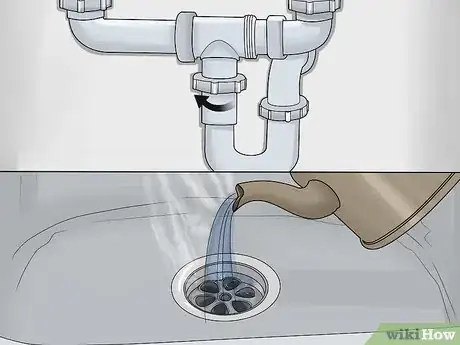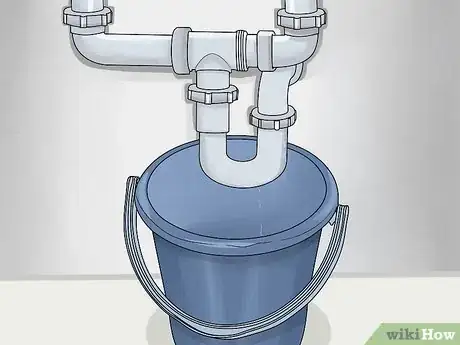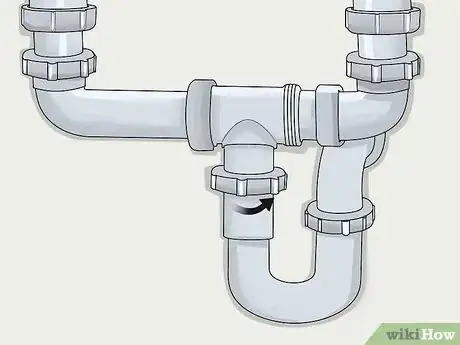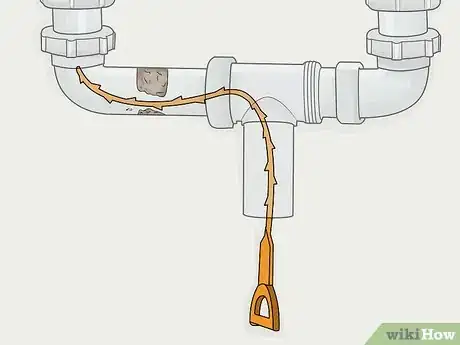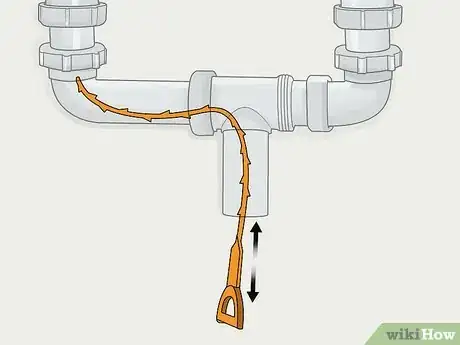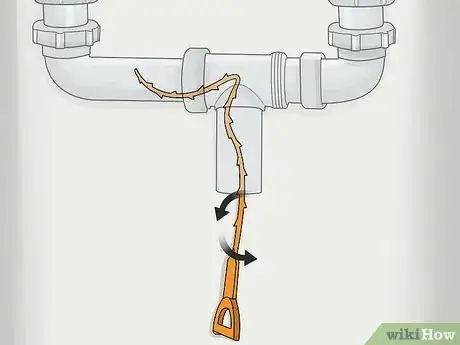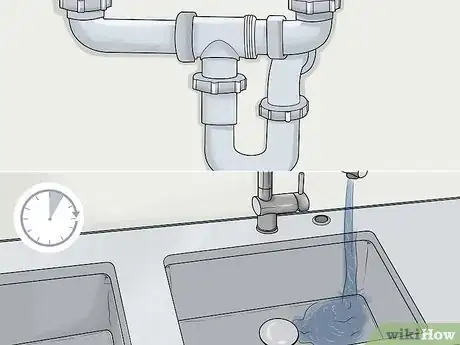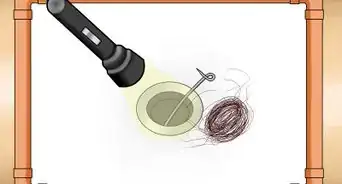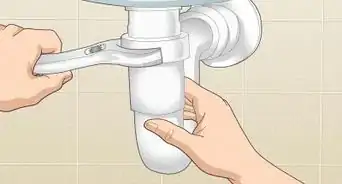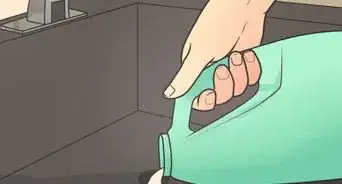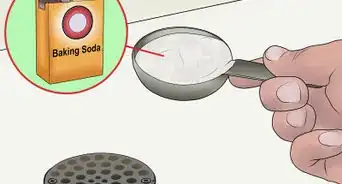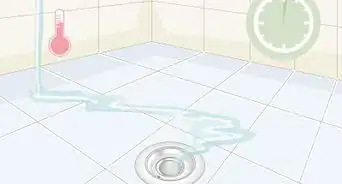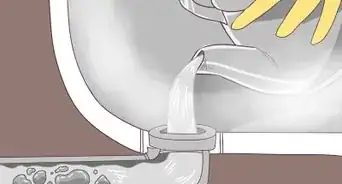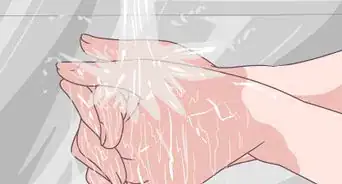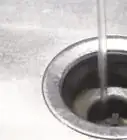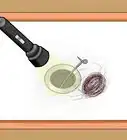This article was co-authored by James Schuelke and by wikiHow staff writer, Hunter Rising. James Schuelke, along with his twin brother David, is the co-owner of the Twin Home Experts, a licensed plumbing, leak detection, and mold inspection company based in Los Angeles, California. James has over 32 years of home service and business plumbing experience and has expanded the Twin Home Experts to Phoenix, Arizona and the Pacific Northwest.
There are 11 references cited in this article, which can be found at the bottom of the page.
This article has been viewed 15,739 times.
Double sinks have 2 drains, which can make them more likely to clog if you accidentally rinse down large food scraps. Minor clogs can usually be flushed out or broken apart with water. If your sink is only clogged on one side, plunge the clogged side with a cup plunger to loosen the blockage. If both sides are backed up, then you may need to take out the sink’s trap, which is the curved pipe underneath the sink, to see if it’s clogged. For clogs deeper in the pipes, use a drain snake to access them. If your sink still doesn’t drain properly after repairs, you may need to contact a plumber to check for additional problems.
Steps
Trying Simple Fixes
-
1Run the garbage disposal if the clogged side has one. If there’s no standing water in your sink, turn on a slow stream of hot water from your faucet. Turn on your garbage disposal and let it run for 10 seconds. Turn the disposal off and watch the water level to see if it drains. If it does, then you may have broken apart the clog. Keep running your faucet to make sure it continues to drain at a steady pace.[1]
- If the sink doesn’t drain, turn off the water since the clog may be deeper in the pipes.
- If you hear something solid knocking around when you run the garbage disposal, unplug it and shine a flashlight into the drain. Use a pair of tongs to remove anything stuck in the garbage disposal.
Warning: Never stick your hand into a drain with a garbage disposal since you could seriously harm yourself if it turns on.
-
2Try using baking soda and vinegar to break apart small clogs. Slowly pour 1 cup (230 g) of baking soda directly into the clogged side of the sink and wait for about 3–4 minutes. After that, add 1 cup (240 ml) of distilled white vinegar to the same drain. Plug the drain and let the baking soda and vinegar fizz for about 10 minutes so it can break apart the blockage. Run hot water in the sink to flush out the baking soda and vinegar to see if it broke the clog.[2]
- Push the baking soda deeper into the drain with a wooden spoon or utensil if it didn’t all go into the drain.
- Baking soda and vinegar usually only works to break apart smaller food particles.
Advertisement -
3Pour boiling water into the drain to force or melt the clog. Carefully dump a full pot of boiling water into the clogged side of the sink so it goes directly into the drain. If the water starts draining, then the heat may have melted solidified residue or pushed the clog out from the pipes.[3]
- If the water doesn’t drain, wait for it to cool down so you don’t burn yourself trying other methods.
Plunging the Sink
-
1Block the drain on the unclogged side of the sink. Use the drain plug that came with your sink if you have one, or stuff a towel into the drain. Make sure you create a tight seal on the unclogged side, or else your plunger won’t work properly.[4]
- Since a plunger can cause pressure to build up, ask a helper to hold the drain plug in place so it doesn’t come loose.
-
2Fill the clogged side of the sink with 3–4 in (7.6–10.2 cm) of water. Use the warmest water than you can handle when you fill the clogged side of your sink. Make sure there’s at least 3–4 inches (7.6–10.2 cm), or else the plunger won’t seal around the drain properly.[5]
- If you already have standing water in your sink, you can skip this step.
-
3Place a plunger around the clogged drain. Use a cup plunger if you have one since they’re designed for sink drains. If you only have a toilet plunger, tuck the flange (the cylindrical part that sticks out of the cup) up into the cup so it's out of the way and you can get a tight seal around the drain. Whichever kind you use, press the rim of the cup around the drain and push down lightly so it forms a tight seal. Keep the plunger handle vertical or else you may cause the plunger to lose suction.[6]
- You may be able to find a plunger with a short handle so it’s easier to maneuver in your sink.
-
4Pump the plunger up and down for 30 seconds. Hold the plunger’s handle so it stays vertical and push it straight down to create suction inside the drain. Pull the handle up quickly, but not so forcefully that you take the plunger out of the sink. Continue pushing the handle down repeatedly for at least 30 seconds to loosen the clog in your pipes.[7]
- If you’re worried about the plunger splashing you with water, wear gloves and an apron so you don’t get dirty.
Tip: If you don’t have a helper, use your dominant hand to operate the plunger and your nondominant hand to hold the drain plug in place on the other side of the sink. That way, you don’t lose suction.
-
5Remove the plunger to see if the sink drains. Carefully lift the plunger out of the water so you don’t splash water out from the sink. Check if the water spirals or begins draining. If the water drains quickly, then you forced the clog out from the pipes. If it drains slowly or doesn’t empty, try plunging the drain again for another 30 seconds before checking again.[8]
- If the plunger didn’t work after the second time, you may need to check the sink’s trap or use a drain snake.
Removing the Trap
-
1Place a bucket underneath the sink’s drainage pipe. Look for the U-shaped section of pipe under your sink, which is known as the trap. Use a bucket that’s large enough to hold all of the standing water in your sink and set it directly under the trap. Put cleaning rags around the outside of the bucket in case any water splashes out.[9]
- You may also use a garbage bag or garbage can if you have room underneath your sink.
Tip: If you don’t have a large enough bucket to hold all of the water that’s stuck in your sink, bail out the standing water and pour it down a different drain in your home. Then place the bucket underneath the pipes.
-
2Unscrew the nuts on each side of the trap. Locate the nuts or pipe connectors on both sides of the trap and try turning them counterclockwise by hand to see if they come loose. If they’re too tight, grip them with a pair of pliers and continue loosening them until the trap comes off of the pipes. Let any water or debris drain into the bucket.[10]
- If you’re worried about getting splashed with dirty water, wear rubber gloves.
-
3Try pushing a wire hanger through the trap to remove the blockage. Unbend a wire hanger so you have a long straight piece. Push one end of the wire into the trap and force it in as far as you can push it. If you meet resistance, push and pull the wire to break apart the clog. Let the clog fall into the bucket so you can easily dispose of it.[11]
- If you don’t feel any resistance, then the clog may be deeper in the pipe and you’ll need to use a snake to get rid of it.
-
4Rinse the trap clean in a different sink. Hold the trap underneath a faucet with hot water and let it go through the pipe. Make sure to rinse out each side of the pipe so you can clean out any debris that may be stuck on the inside. If water flows through the trap easily, then you’ve removed the clog.[12]
- If water still gets stuck in the trap, then try using the wire hanger to break apart the clog or scrape the sides of the pipe.
- You can also use your garden hose with a jet attachment to forcefully clean out the trap.
-
5Reattach the trap and try running water in the sink. Position the pipe back underneath your sink so it lines up with the pipes leading to and away from your sink. Screw the nuts tightly back into place by hand or with your pliers so they don’t leak. Turn on your faucet with hot water and run it on each side of the sink for about 5 minutes. If it doesn’t back up, then you have cleaned out the clog.[13]
- If the sink still clogs on either side, then the blockage may be further down the pipe.
Snaking the Drain Pipe
-
1Set a bucket under the sink’s trap. Make sure you use a bucket large enough to hold all of the standing water in your sink. Locate the U-shaped trap connected to the sink’s drains and place the bucket underneath it so the pipes can drain directly into it.[14]
- Put a bucket underneath your sink even if you don’t have standing water since there may still be some liquid that comes out from the pipes.
- You can also use a garbage bag or garbage can.
-
2Loosen the nuts on the trap with a wrench to remove it. Locate the nuts or fasteners on each side of the trap and try turning them counterclockwise by hand. If they’re too tight to remove on your own, use a pair of pliers to loosen them. Unscrew the nuts or fasteners completely so the trap comes loose, and let the water drain into the bucket.[15]
- Hold the trap upside-down over the bucket since it may also have water stuck inside of it.
-
3Feed the end of a drain snake into the waste pipe until you hit the blockage. Take the round end of the drain snake and position it in the pipe that’s leading away from your sink. Push about 1 foot (30 cm) of the snake into the pipe by hand before turning the handle clockwise to extend it further. Keep unwinding the drain snake until you meet resistance or until you run out of wire.[16]
- A drain snake has a long wire stored inside of a drum so you can feed it in and out of your pipes without cutting them.
- You can buy drain snakes from hardware stores or online.
- If you’ve used the full length of the drain snake and you haven’t felt the blockage, then contact a plumber since you have problems further down in your pipes.
-
4Push and pull the snake back and forth if you feel a clog. Wiggle the snake around the pipe for about 5 seconds before rotating the handle counterclockwise by a half turn. Forcefully turn the handle clockwise again to force the snake into the blockage. Continue pushing and pulling the end of the snake into the clog until you don’t feel any more resistance.[17]
- If you feel resistance even when you’re pulling the snake back toward you, the clog may have caught on the end.
Variation: Some drain snakes allow you to attach a drill to them so you can quickly push and pull them through your pipes. Check the user manual for your snake to see if it’s compatible.
-
5Turn the handle counterclockwise to retrieve the snake. Use a slow and steady pace in case the blockage caught on the end of the snake so it doesn’t fall off inside the pipe. Keep pulling the snake out until you reach the end, and clean off any debris stuck on it with a paper towel.M Make sure the snake is completely inside the drum so you don’t damage or break it.[18]
- Wipe the snake with a paper towel or cleaning rag as you retract it to help keep it clean.
-
6Reassemble the pipes and test the drain. Position the trap back onto the pipes and tighten the nuts or fasteners with your pliers. Turn your faucet to the hottest setting and run it in 1 side of the sink for 5 minutes to make sure it drains properly. Then move the faucet so the water runs on the other side of the sink to ensure it doesn’t clog.[19]
- If the water still backs up in the sink, contact a plumber to check your drain lines since they may have damage farther than what you’re able to reach.
Warnings
- Never stick your fingers into a drain with a garbage disposal.[21]⧼thumbs_response⧽
- If you’re unable to remove the clog on your own, contact a plumber since there may be damage further down the pipe that you’re unable to access.[22]⧼thumbs_response⧽
- Avoid using chemical drain cleaners, especially if you have a septic tank, since you can kill helpful bacteria.⧼thumbs_response⧽
Things You’ll Need
Trying Simple Fixes
- Baking soda
- White distilled vinegar
- Pot
Plunging the Sink
- Plunger
- Drain plug or rag
Removing the Trap
- Bucket
- Pliers
- Wire hanger
- Hose
Snaking the Drain Pipe
- Bucket
- Pliers
- Drain snake
- Paper towel
References
- ↑ https://www.bobvila.com/articles/clogged-kitchen-sink/
- ↑ https://www.cnet.com/how-to/3-ways-to-unclog-a-kitchen-sink-using-things-you-already-have-around-the-house/
- ↑ https://www.bobvila.com/articles/clogged-kitchen-sink/
- ↑ https://www.housing.sjsu.edu/housingaz/plumbing/
- ↑ https://www.bobvila.com/articles/clogged-kitchen-sink/
- ↑ https://www.housing.sjsu.edu/housingaz/plumbing/
- ↑ https://www.bobvila.com/articles/clogged-kitchen-sink/
- ↑ https://www.cnet.com/how-to/3-ways-to-unclog-a-kitchen-sink-using-things-you-already-have-around-the-house/
- ↑ https://www.cnet.com/how-to/3-ways-to-unclog-a-kitchen-sink-using-things-you-already-have-around-the-house/
- ↑ https://youtu.be/r25zMpTPotA?t=81
- ↑ https://www.cnet.com/how-to/3-ways-to-unclog-a-kitchen-sink-using-things-you-already-have-around-the-house/
- ↑ https://www.bobvila.com/articles/clogged-kitchen-sink/
- ↑ https://youtu.be/r25zMpTPotA?t=440
- ↑ https://www.bobvila.com/articles/clogged-kitchen-sink/
- ↑ https://youtu.be/r25zMpTPotA?t=86
- ↑ https://youtu.be/r25zMpTPotA?t=319
- ↑ https://www.bobvila.com/articles/clogged-kitchen-sink/
- ↑ https://youtu.be/r25zMpTPotA?t=327
- ↑ https://youtu.be/r25zMpTPotA?t=440
- ↑ James Schuelke. Professional Plumber. Expert Interview. 1 October 2019.
- ↑ https://www.bobvila.com/articles/clogged-kitchen-sink/
- ↑ https://www.bobvila.com/articles/clogged-kitchen-sink/
